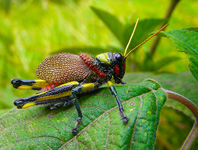Abstract
Four species of the fish genus Pempheris are recognized for the Red Sea: P. adusta Bleeker, 1877; P. mangula Cuvier, 1829; P. nesogallica Cuvier in Cuvier & Valenciennes, 1831; and a new species P. tominagai. All are wide-ranging in the western Indian Ocean, and P. mangula has migrated via the Suez Canal to the eastern Mediterranean Sea. Morphological and genetic analysis of 15 species in this genus show that P. adusta, a widely distributed species, that can't be divided into different species, because of the continuity of morphologies and distribution, and lack of variance in genetics between Indian Ocean, Red Sea, and Pacific Ocean populations. This confirms that the two subspecies described by Randall et al. (2013) are both synonyms of P. adusta. Pempheris adusta is distinguished from other species by a blackish spot on pectoral fin base, pored lateral-line scales 56–64, scale rows above lateral line 4 1/2–6 1/2, distinct blackish band on outer edge of anal fin, and blackish band on posterior edge of caudal fin. Pempheris mangula was named by Cuvier (1829) in a footnote making reference to a drawing and short description in Russell (1803) of a Pempheris from southeast India, giving only the native name ''Mangula-Kutti'', and listing no specimen. The wide distribution of this species, from the Indian Ocean to the Red Sea is also demonstrated by morphological and genetic analysis. Thus, the specimen collected from southern India is herein designated as the neotype. This species is distinguished from other species by its huge eye, deep body, blackish tip of the dorsal fin, pored lateral-line scales 49–60, and scale rows above lateral line 4 1/2–5 1/2. The extant syntype of Kossmann & Räuber's P. rhomboidea is designated as the lectotype of the species; however, P. rhomboidea is a synonym of P. mangula. In addition, Kossmann & Räuber's Pempheris erythraea and P. russellii Day, 1888 are also synonyms of P. mangula. Of two existing syntypes of P. nesogallica from Mauritius, one is designated as the lectotype, the other is re-identified as P. mangula; P. nesogallica is presently known only from the southern Red Sea. This species has a similar morphology to P. mangula, but can be distinguished by a smaller eye than P. mangula, and lack irregular faint longitudinal light stripes on the body side. Pempheris tominagai are distinguished from P. schwenkii Bleeker 1855, formerly misidentified, by the form of posterior nostril, scale counts, color of caudal fin, and by a 2.1% mitochondrial DNA sequence divergence.

